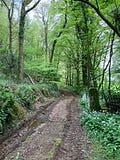Winter was finally over, the wild garlic had shot its load, and, although the car boot sale had been rained off, the sun was attempting to prise apart the clouds and just the right amount of refreshing breeze was tickling the infant bluebells in the hedgerows, so it seemed as good a time as any to set out on a long, exhausting walk. As I studied OS Expl…
© 2024 Tom Cox
Substack is the home for great culture



